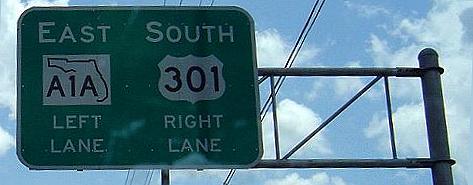

The twin towns of Hilliard and Callahan sit like the hubs of great wagon wheels, all the highways in Nassau County gravitating towards one or the other. Both have the railroad at their backs; the CSX Railroad tracks are never very far from US One. Both are small towns, but that's where the fraternal similarities end. Hilliard is the meeting place of lonely two-lane blacktops that disappear out into the scrub forests of north Florida, roads that only locals and truckers use, fanning out to meet US 17 and the Georgia border. Others dead end at the St. Mary's River, going nowhere, underscoring the isolation of this remote part of Florida.
Just six minutes away, Callahan booms, partly due to geography and partly due to commerce. US 301 funnels traffic into town from Baldwin, Macclenny, Starke and Gainesville to congregate at the very intersection where A1A is born, the highway of dreams. To the east lie Yulee and Fernandina, US 17 and Interstate 95, proving the old real estate maxim that location is everything. The rapid expansion of Jacksonville to the south has pumped money into Callahan's economy as the town has slowly become yet another bedroom community for those willing to commute in order to escape the pressure of big city living.

The better part of both town centers lie just a few blocks west of US One. It takes a practiced eye to realize that one is in the heart of a small town. In contrast to the modernity of its sister, Hilliard is a step-child in hand-me-down clothes. Except for the continual stream of log trucks along the highway, it has all the earmarks of a dying community. Shabby and disheveled, it is mostly a blue-collar town, existing for the working-class families it shelters and it makes no apologies. Ironically enough, in a large facility just two blocks off the main highway, a very high-tech employer maintains a very low profile. Surrounded by high chain-link fences topped with barbed wire is the FAA's communications facility, that monitors and relays all the air traffic control transmissions for the Jacksonville International Airport. In this post-9/11 world, it is the equivalent of hiding in plain sight.
Hilliard has another surprise for those who care to look into her past. Until 1998, it was home for two survivors of the Rosewood Massacre- Wilson Hall and Margie Hall Johnson. The all-black community of Rosewood, Florida was destroyed in January of 1923 in a firestorm of racial hatred initiated by the Ku Klux Klan. To avoid being shot, lynched or burned alive, residents fled into the swamps to hide out, making their way to safety in larger towns. A Grand Jury the following month found "insufficient evidence to prosecute" and it was not until 1994 that the State of Florida made financial restitution for the losses of Rosewood residents. In fact, Rosewood was the second black town to be destroyed. The village of Ocoee was burned to the ground in November of 1920 with an equal or greater number of residents murdered. No one has ever been convicted and sentenced in connection with either event. It is a brutal reminder of racial attitudes in Florida that persisted until the early seventies and is often lying dormant just under the surface today. It is a cancer in remission, but not yet cured.
It was after one o'clock when I rolled in and my rumbling stomach found a barbecue kitchen hard to pass up. The delicious aroma of hardwood smoke assaulted me when I stepped down onto the parking lot, but inside Patricia Anns, I discovered a buffet with fried chicken, immediately banishing any desire for smoked pork. Fried chicken is food for the gods, my fatal weakness. Here it was heaped on a steam table, nesting by a huge pan of homemade mashed potatoes, collard greens, pole beans and corn. Tucked into a corner was a tub full of blueberry cobbler and a platter of bread pudding. I filled a Melmac plate to the edge and forced myself into a booth made for a lankier man, ready to eat myself comatose. A waitress brought my drink in a styrofoam tumbler that looked like a one quart pitcher while I reinforced the wall of mashed potatoes that held in a lake of gravy. Around me, truckers talked speed traps and short cuts, how logs should be loaded and who runs the best skidder. In the far corner, two men discussed the merits of fatback bacon and sweet tea, where you'd find it and where you won't.
The food was plain but hearty, the desserts heavy and sweet. This is not fare for epicures, but cooked for men who work hard and drive long. This is food to stay in the belly and sustain the body until quitting time. It is roadhouse eating at its best.
It takes just six minutes to leave Hilliard and enter Callahan, but it seems like another world. Out near the fairground, one piece of history still connects the two towns. In the blink of an eye, the casual traveler would miss it, but high on a street corner is a sign that reads "Old Dixie Hwy". From the Florida border until now, I have been traveling on what was once a turnpike as famous as Route 66. Almost unremembered, the Dixie Highway was an "auto-trail" that stretched from Michigan to Miami in the first decade of the twentieth century. Its heyday only lasted ten years; when it was absorbed into the new national highway system with new route numbers, the Dixie Highway disappeared. Only a few street signs here and there mark the old routes where they deviate out from under US One.

Callahan seems vaguely familiar but oddly foreign, as if upon coming home from a long trip, you found your furniture completely rearranged. I once spent a lot of time driving here and back from the south side of Jacksonville. I thought I was in love then and maybe I was, but in time, it unraveled. She was going to be a marine biologist and I was going nowhere. In my minds eye, I can still see a younger me blasting down the highway in a '67 VW, with a red-haired beauty beside me. But thirty years have come and gone, changing the landscape in more ways than one.
The bank sign in Callahan reads ninety degrees as clouds begin to darken. Rain comes in fits and spells, never quite soaking the ground, but steaming off the hot pavement almost as fast as it falls. Maintenance workers are mowing in the medians of US One and the aroma of fresh cut grass mingling with the smell of pavement steam is almost overpowering. It is a cloying mixture of sweet and brackish scents that evoke summer and road trips, picnic shelters in the rain and the perfume of new hay in the barn. On the way out of town, a salvage yard offers discount car parts, the entire front end of a dozen cars perch on steel racks as if in a display case. It almost seems as if they had been lined up at a drive-in movie and were cut in half by a giant laser, their occupants mysteriously transported away. The sun is back out already and bounces off the gleaming chrome grillwork of a split Buick Regal that is in danger of being swallowed by vines as it waits for new life. Just yards away, US One crosses Thomas Creek into Duval County and Metro Jacksonville. Once, this was home.